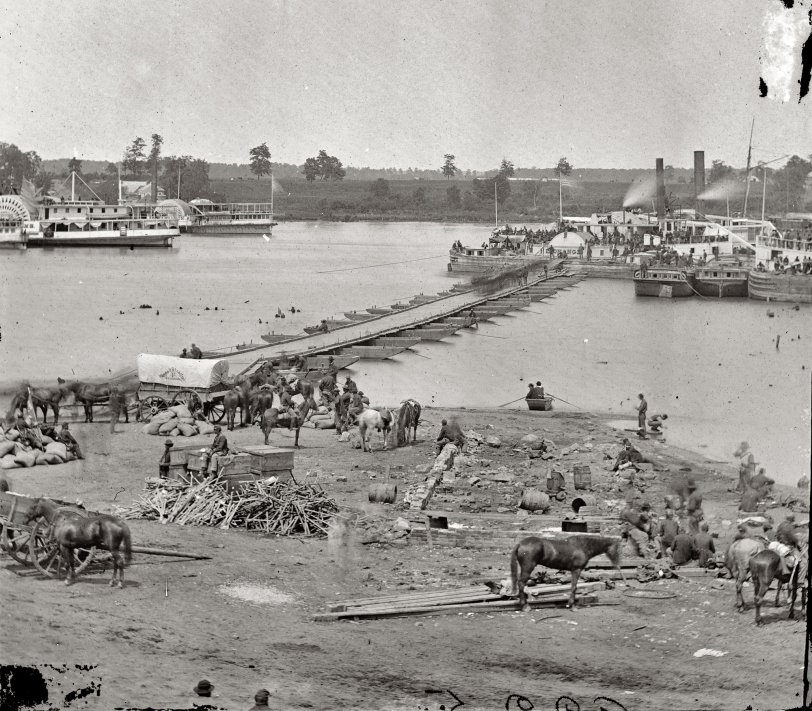


Framed or unframed, desk size to sofa size, printed by us in Arizona and Alabama since 2007. Explore now.
Shorpy is funded by you. Patreon contributors get an ad-free experience.
Learn more.

- Lofty addition
- In 1912
- Keenan Building
- Six years old
- Taken from the P.J. McArdle Roadway?
- It stood only 47 years
- Three track mind
- Incline to the right
- Reach for the sky, 1912 style
- No clean sweep
- Same Job Title, Same Face
- Sadly Lost
- Beautiful ...
- Where you get your kicks
- Aim High
- Pueblo Revival sisters
- Pueblo Neoclassicism
- Milk Man
- Regional dialect.
- Spielberg's inspiration
- Great Photo
- Loaf Story
- Do you still have the Rakes category?
- Could almost be a scene from the 1957 movie 'Hell Drivers'
- The Wages of Fear.
- Conspicuous by their absence
- Got Milk?
- All that aluminum
- No lefties
- Smoke 'em if you've got 'em
Print Emporium
Evacuation: 1864

May 30, 1864. "Port Royal, Virginia. The Rappahannock River front during the evacuation." Photograph from the main Eastern theater of war, Grant's Wilderness Campaign. Wet plate negative by Timothy O'Sullivan. View full size.
Cool Place
Port Royal is still a very cool place. It is out in the country, at the intersection of two major highways. There is a fabulous old-style tourist trap - Horne's - where you can get a great cheeseburger AND a pair of boxers printed with the Southern Cross. Up at the river there is a street, maybe three blocks long, with good early houses. The historic stuff is scattered over maybe six blocks. There is even at least one standing slave quarter, right beside highway 301. If you follow 301 south a mile or so up into the uplands, there is a historical marker and you drive through the space once occupied by the Garrett barn, where John Wilkes Booth was killed.
A Very Different war...
Less than 80 years later, there was a Japanese submarine on display down near the Rappahannock--in 1942 we were at the Princess Anne Hotel in Fredericksburg.
The Rappahannock
I grew up on the Rappahannock River, although 20 miles up river in Fredericksburg. It's almost unfathomable for me to imagine the dinky little town I grew up in being such a major part of US History. I mean, sure, we learned about it in school, visited the battlefields and even unearthed the occasional Civil War bullet in our yard, but seeing the pictures help put it in perspective. Thanks!
Shovel anyone?
Now that's a lot of shovels, pickaxes and whatevers in that pile. Are those barges in the upper right?
Covered Wagon
If I read it correctly, the canvas on the covered wagon reads "Headquarters 4th NY Cavalry." According to the New York Military History Museum webpage, the 4th New York Cavalry was mustered into service between August 10 and November 15 1861. With the exception of H company (which was at least partially recruited around Cleveland Ohio!) the regiment was drawn from New York City, Brooklyn, Yonkers, and Poughkeepsie. The regiment went through various parts of the Army of the Potomac as the Army was reorganized several times. For most of May 1864 they were attached directly to the headquarters of the Army of the Potomac before being returned to the Cavalry Corps under Sheridan on May 30th, 1864. The regiment was amalgamated with the 9th New York Volunteer Cavalry at the end of February 1865. During its time in service the regiment lost 4 officers and 40 enlisted men killed in action, 1 officer and 12 enlisted men died of wounds received in battle, with 3 officers and 54 enlisted men dying of disease or other causes. In other words, in this regiment more enlisted men died of disease than of action with the enemy.
Look again
You can see the outline of a shirt--because the ground and the shirt are 'reading' the same color, it looks like a disembodied head.
Ghost Soldiers
Does the covered wagon have the words "head quarters" written on its side? I suppose the photographer used a similar wagon to carry supplies and also use as a darkroom. The band of ghost-like men crossing the pontoon bridge seems prophetic. How long did someone being photographed have to stand still to get a solid image?
























On Shorpy:
Today’s Top 5